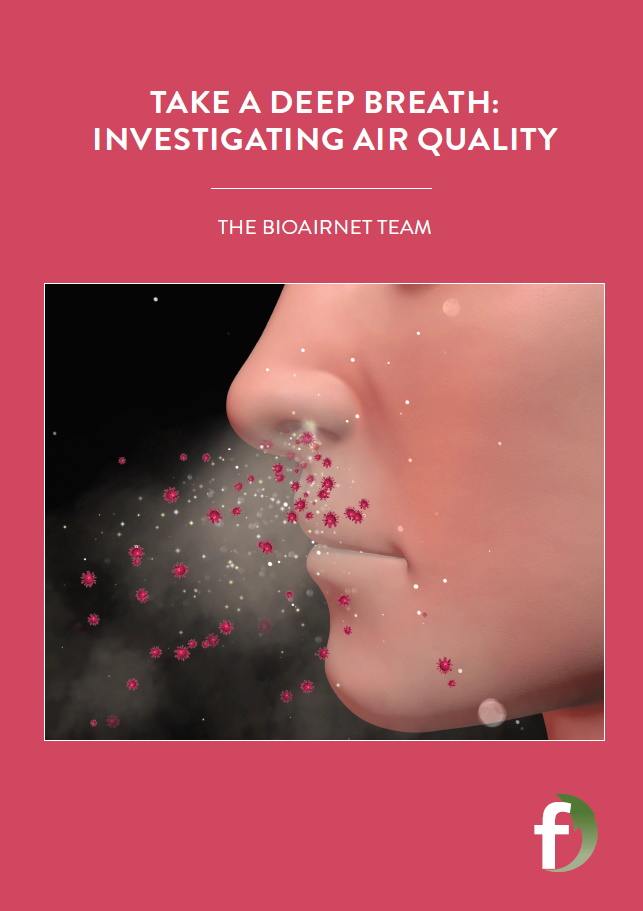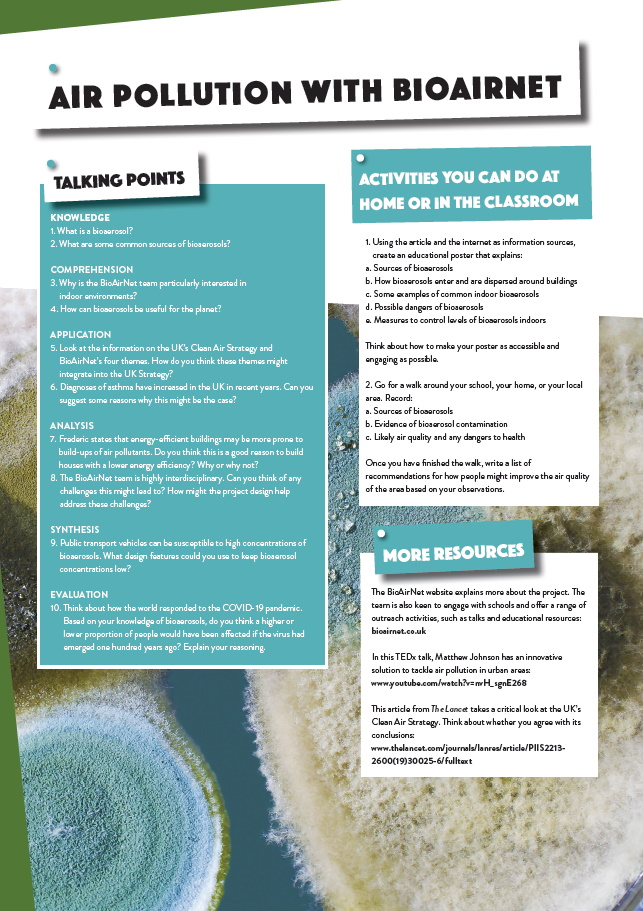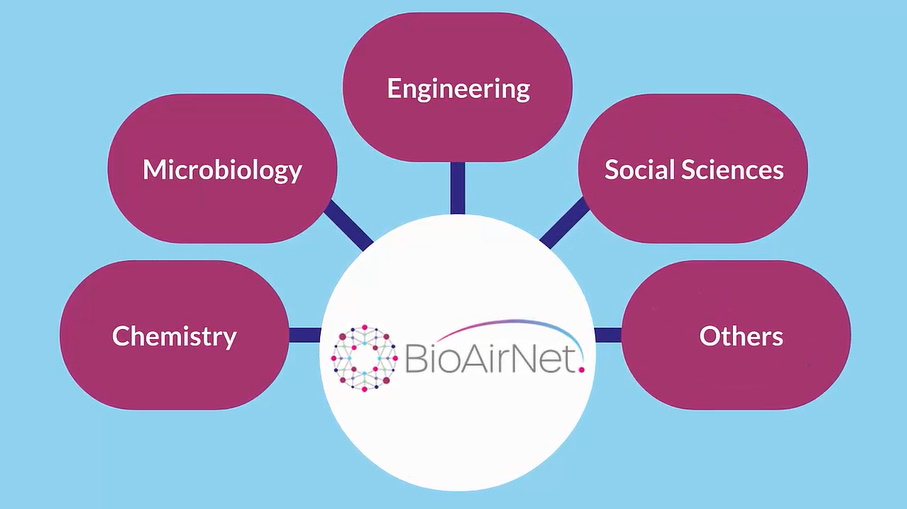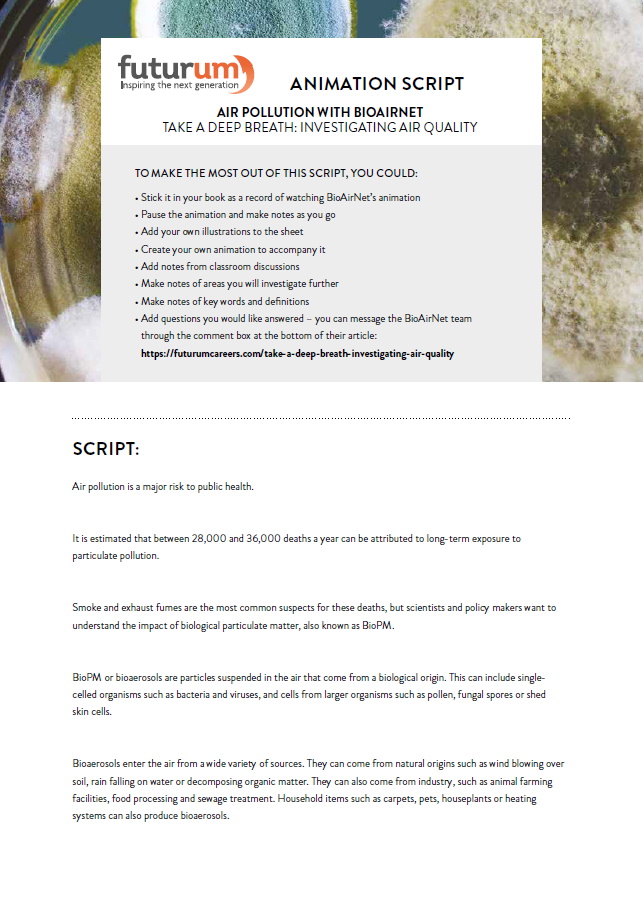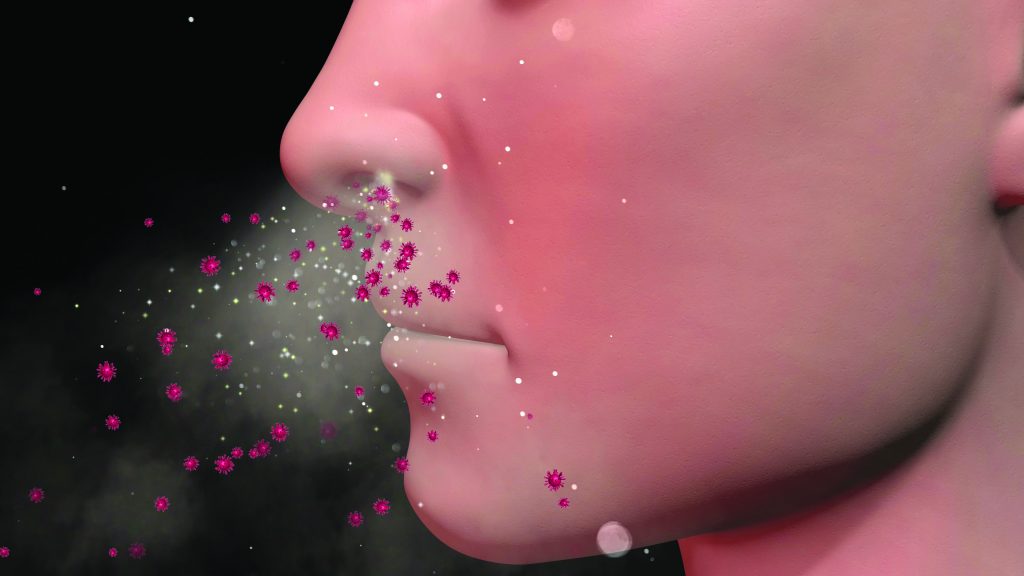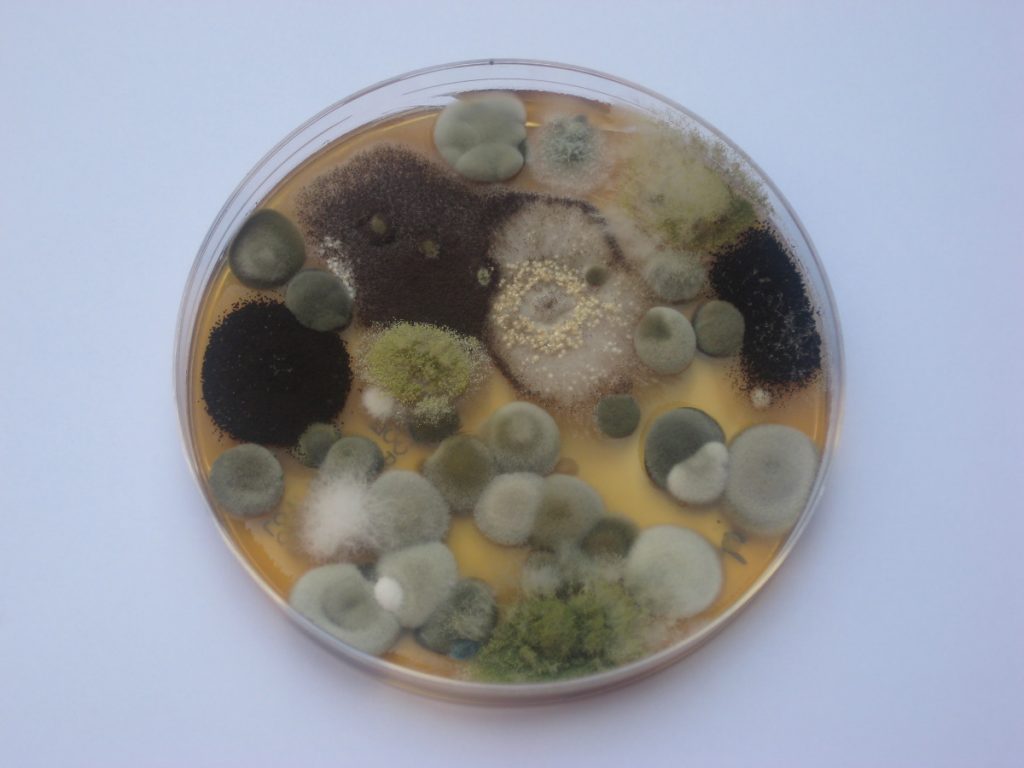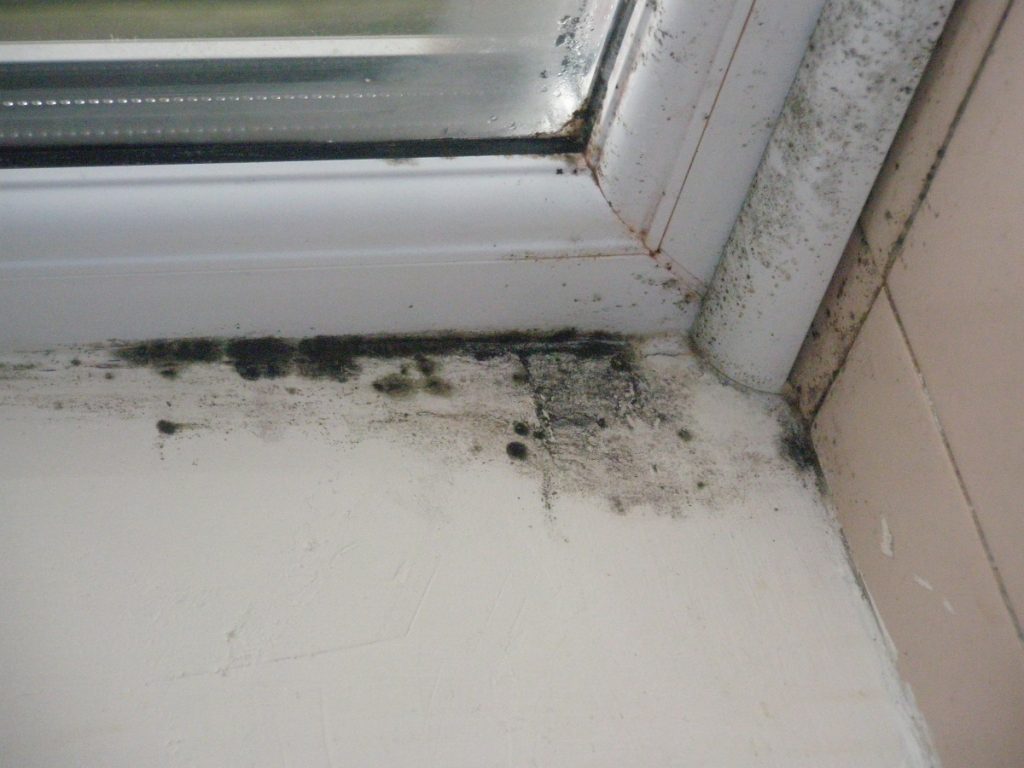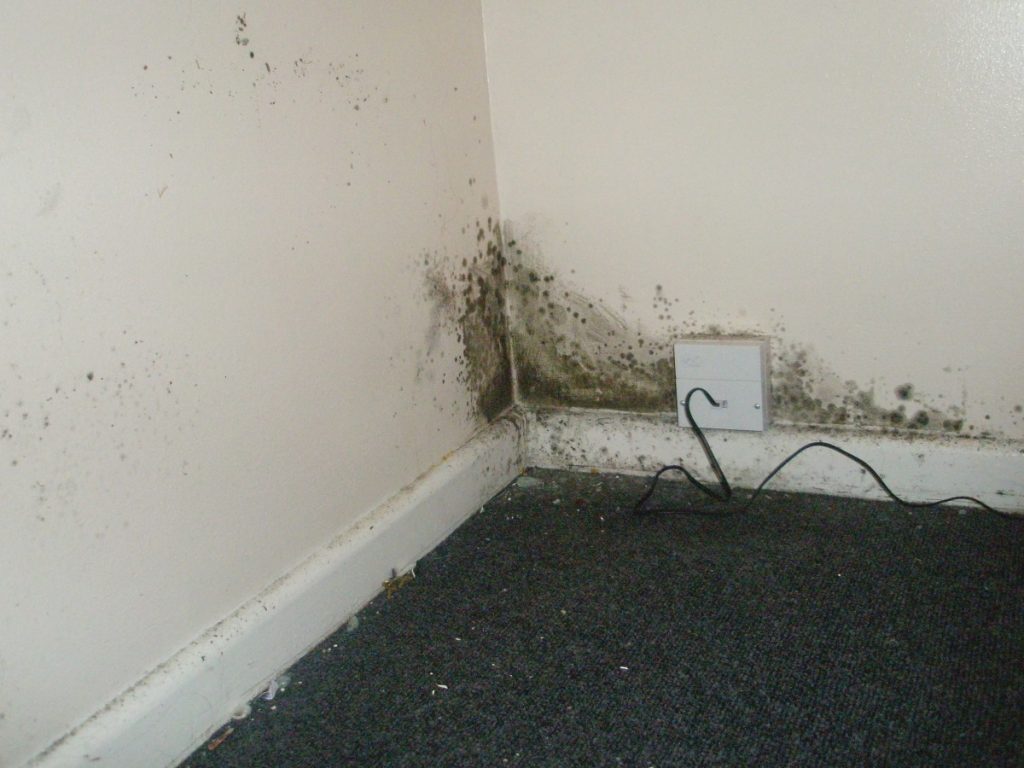Take a deep breath: Investigating air quality
The air is full of aerosolised microscopic matter that enter our lungs with every breath. The BioAirNet team is investigating aerosols of biological origin, what they mean for our health, and how we can improve the air quality of the places we spend time in
AIR QUALITY TERMINOLOGY
AEROSOLS – particles suspended in the air
AIR POLLUTION – the presence of substances in the air that have harmful effects
BIOAEROSOL – aerosol of biological origin
BIOAIRNET – Indoor/Outdoor Bioaerosols Interface and Relationships Network
BioPM – biological particulate matter; another term for bioaerosols
HVAC SYSTEMS – heating, ventilation and air conditioning systems
“Air pollution is a major risk to public health in the UK,” says Frederic Coulon, Professor of Environmental Chemistry and Microbiology at the Cranfield Water Science Institute, and Principal Investigator of the BioAirNet team. “It is estimated that between 28,000 – 36,000 deaths a year in the UK can be attributed to long-term exposure to particulate pollution.”
Smoke and exhaust fumes are the most common suspects for these deaths, but less well-understood are the effects of biological particulate matter (known as BioPM). This is what the BioAirNet team is focused on finding out.
The BioAirNet team also hopes to remedy a common stumbling block when tackling largescale challenges such as air pollution. “A lack of cohesion between communities of researchers and users can limit research and innovation, and this can affect the application of new science within policy,” says Dr Zaheer Nasar, Academic Fellow in Atmospheric Aerosols at the Centre for Environment and Agricultural Informatics, Cranfield University. “To ensure this is not the case with our project, BioAirNet is highly interdisciplinary.”
WHAT ARE BIOAEROSOLS?
There are lots of different particles floating about in the air, most of which we cannot see. The collective term used for them is aerosols. The BioAirNet team works on a particular type of aerosol known as bioaerosols – any aerosol from a biological origin. This can include single-celled organisms such as bacteria and viruses, and cells from larger organisms such as pollen, fungal spores or shed skin cells.
Bioaerosols enter the air from a wide variety of sources. They can come from natural origins – wind blowing over soil, rain falling on water or decomposition of organic matter, for instance. They can also come from industry, such as animal farming facilities, ventilation systems, food processing and sewage treatment. Household items such as carpets, pets, houseplants or heating systems can also produce bioaerosols.
Bioaerosols fulfil a number of useful purposes. They have a role to play in regulating the climate, such as through contributing to the creation of clouds, which absorb and scatter sunlight. Some also have an important biological function, like plants using airborne pollen or fungi using spores to reproduce. However, bioaerosols also have the potential to harm human health. Some bioaerosols, such as pollen, fungal spores and cells from pets, can provoke allergic reactions. But most significantly, many disease-causing microbes, or pathogens, have a potential to be dispersed via the air.
BIOAEROSOLS INDOORS
“Micro-organisms can enter indoor environments through various routes,” says Zaheer. “Doors and windows, HVAC systems, and our shoes and clothes are common entry points.” Once inside, microbes can get established if they find a suitable environment. “For instance, damp conditions can help microbes grow and multiply, leading to high levels of bioaerosols indoors,” explains Zaheer. “These can be harmful for human health, such as increasing the risk of respiratory disease.”
Indoor environments are of special interest to the BioAirNet team. “We spend a lot of time indoors, so we are more likely to have a high exposure to bioaerosols in these environments,” says Frederic. “Our exposure may also be changing over time. It is possible that more energy-efficient buildings, with increased insulation, may have reduced ventilation, which results in higher concentrations of air pollutants.” Those most vulnerable to harmful bioaerosols, such as the ill or elderly, also typically spend more of their time indoors.
BIOAEROSOLS IN TODAY’S WORLD
“Today we are facing unprecedented levels of airborne biological threats,” says Zaheer. “Globalisation, urbanisation, and changes to the environment and climate mean that disease transmission cycles are changing significantly.” This was exemplified by the COVID-19 pandemic, where an airborne disease was rapidly spread around the world by international travellers.
Built environments have a major role to play in managing bioaerosols. “For instance, outbreaks of Legionnaires’ disease arise from contaminated water systems and air conditioning units within buildings,” says Frederic. “People are infected by breathing in airborne water droplets containing the pathogen.” Hospitals provide another example, especially given that they contain high numbers of both infected and vulnerable people. There is a need for hospitals to be designed or maintained to ensure airborne micro-organisms are flushed from the building as effectively as possible.
BIOAIRNET
“BioAirNet has been set up to tackle emerging air pollution challenges and associated health risks,” says Frederic. “This includes exploring human behavioural changes and technology interventions that can improve air quality.” The network encompasses professionals with many different areas of expertise, to make sure that all bases are covered.
BioAirNet has four interconnected themes:
Reference
https://doi.org/10.33424/FUTURUM168
AEROSOLS – particles suspended in the air
AIR POLLUTION – the presence of substances in the air that have harmful effects
BIOAEROSOL – aerosol of biological origin
BIOAIRNET – Indoor/Outdoor Bioaerosols Interface and Relationships Network
BioPM – biological particulate matter; another term for bioaerosols
HVAC SYSTEMS – heating, ventilation and air conditioning systems
“Air pollution is a major risk to public health in the UK,” says Frederic Coulon, Professor of Environmental Chemistry and Microbiology at the Cranfield Water Science Institute, and Principal Investigator of the BioAirNet team. “It is estimated that between 28,000 – 36,000 deaths a year in the UK can be attributed to long-term exposure to particulate pollution.”
Smoke and exhaust fumes are the most common suspects for these deaths, but less well-understood are the effects of biological particulate matter (known as BioPM). This is what the BioAirNet team is focused on finding out.
The BioAirNet team also hopes to remedy a common stumbling block when tackling largescale challenges such as air pollution. “A lack of cohesion between communities of researchers and users can limit research and innovation, and this can affect the application of new science within policy,” says Dr Zaheer Nasar, Academic Fellow in Atmospheric Aerosols at the Centre for Environment and Agricultural Informatics, Cranfield University. “To ensure this is not the case with our project, BioAirNet is highly interdisciplinary.”
WHAT ARE BIOAEROSOLS?
There are lots of different particles floating about in the air, most of which we cannot see. The collective term used for them is aerosols. The BioAirNet team works on a particular type of aerosol known as bioaerosols – any aerosol from a biological origin. This can include single-celled organisms such as bacteria and viruses, and cells from larger organisms such as pollen, fungal spores or shed skin cells.
Bioaerosols enter the air from a wide variety of sources. They can come from natural origins – wind blowing over soil, rain falling on water or decomposition of organic matter, for instance. They can also come from industry, such as animal farming facilities, ventilation systems, food processing and sewage treatment. Household items such as carpets, pets, houseplants or heating systems can also produce bioaerosols.
Bioaerosols fulfil a number of useful purposes. They have a role to play in regulating the climate, such as through contributing to the creation of clouds, which absorb and scatter sunlight. Some also have an important biological function, like plants using airborne pollen or fungi using spores to reproduce. However, bioaerosols also have the potential to harm human health. Some bioaerosols, such as pollen, fungal spores and cells from pets, can provoke allergic reactions. But most significantly, many disease-causing microbes, or pathogens, have a potential to be dispersed via the air.
BIOAEROSOLS INDOORS
“Micro-organisms can enter indoor environments through various routes,” says Zaheer. “Doors and windows, HVAC systems, and our shoes and clothes are common entry points.” Once inside, microbes can get established if they find a suitable environment. “For instance, damp conditions can help microbes grow and multiply, leading to high levels of bioaerosols indoors,” explains Zaheer. “These can be harmful for human health, such as increasing the risk of respiratory disease.”
Indoor environments are of special interest to the BioAirNet team. “We spend a lot of time indoors, so we are more likely to have a high exposure to bioaerosols in these environments,” says Frederic. “Our exposure may also be changing over time. It is possible that more energy-efficient buildings, with increased insulation, may have reduced ventilation, which results in higher concentrations of air pollutants.” Those most vulnerable to harmful bioaerosols, such as the ill or elderly, also typically spend more of their time indoors.
BIOAEROSOLS IN TODAY’S WORLD
“Today we are facing unprecedented levels of airborne biological threats,” says Zaheer. “Globalisation, urbanisation, and changes to the environment and climate mean that disease transmission cycles are changing significantly.” This was exemplified by the COVID-19 pandemic, where an airborne disease was rapidly spread around the world by international travellers.
Built environments have a major role to play in managing bioaerosols. “For instance, outbreaks of Legionnaires’ disease arise from contaminated water systems and air conditioning units within buildings,” says Frederic. “People are infected by breathing in airborne water droplets containing the pathogen.” Hospitals provide another example, especially given that they contain high numbers of both infected and vulnerable people. There is a need for hospitals to be designed or maintained to ensure airborne micro-organisms are flushed from the building as effectively as possible.
BIOAIRNET
“BioAirNet has been set up to tackle emerging air pollution challenges and associated health risks,” says Frederic. “This includes exploring human behavioural changes and technology interventions that can improve air quality.” The network encompasses professionals with many different areas of expertise, to make sure that all bases are covered.
BioAirNet has four interconnected themes:
1. Investigating the range of BioPM sources in different indoor/outdoor environments and identifying where research is needed.
2. BioPM sampling, to characterise different microbial systems.
3. Exploring effects of exposure to BioPM on human health, and how to prevent this.
4. Policy and public engagement, communicating about how to create healthy environments.
BIOAIRNET AIMS
The project understands that quality and impactful research involves many minds coming together. “We will promote discovery science to answer the pressing questions we have on bioaerosols, facilitating cross-fertilisation of knowledge and interdisciplinary collaboration,” says Zaheer. “We also aim to attract the next generation of academic leaders, by providing leadership opportunities and helping early-career researchers engage with community stakeholders.”
BioAirNet does not just focus on research, but also includes outreach – an essential part of science to ensure that research findings are actually used in society in a meaningful way. “We will foster interactions between academics, businesses and other community-based stakeholders,” says Frederic. “We will also communicate our findings to the wider public.”
Ultimately, outcomes will influence the deployment of the UK’s Clean Air Strategy, helping to make real-world positive changes for UK communities. Additionally, the findings from BioAirNet will be shared with other countries, who can share findings of their own with the UK. The project will also inform the UK’s foreign aid spending, helping to make positive changes to regions suffering from poor air quality. “BioAirNet aims to be the leading voice for the UK BioPM science community,” says Zaheer.
 PROF FREDERIC COULON
PROF FREDERIC COULON
Principal Investigator, BioAirNet
Professor of Environmental Chemistry and Microbiology
Cranfield University, UK
DR ZAHEER AHMAD NASAR
Co-Investigator and BioAirNet Manager
Academic Fellow in Atmospheric
Aerosols, Cranfield University, UK
BIOAIRNET: Tackling air pollution through the Indoor/Outdoor Bioaerosols Interface and Relationships Network (BioAirNet) is one of six networks tackling air pollution. BioAirNet brings together experts from a range of fields, and focuses on bioaerosols.
FUNDER: Natural Environment Research Council (NE/V002171/1)
THE UK’S CLEAN AIR STRATEGY
In 2019, the UK Government published its plans for tackling all forms of air pollution, to benefit human health, the environment and the economy. The conclusions of BioAirNet will influence how this strategy is carried out. Previous legislation has focused on tackling concentrated sources of air pollution – factories, power stations and vehicle exhaust fumes, in particular. Since these major sources have decreased, now the focus is on more spread-out sources of pollution, such as smaller industrial sites, cleaning/maintenance products, open fires in homes and spreading manure on farms.
The Strategy can be broken down into several key parts:
• Understanding the problem: using research and analysis to build a picture of current air quality and the likely impacts of different policies.
• Protecting health – cutting public exposure to air pollution through public engagement and targeted action.
• Protecting the environment – focusing on nitrogen deposition, monitoring and addressing impacts on natural habitats.
• Clean growth and innovation – promoting the development of cleaner technologies through funding and legislation.
• Reducing emissions from transport, at home, from farming, and from industry – setting out policies for each area for targeted reductions.
• Leadership – enabling local action on air pollution and working with international partners.
• Progress – tracking how well the UK is doing in meeting the above targets.
IMPROVING THE AIR QUALITY OF YOUR HOME
At the personal level, hygiene is the most effective way to reduce bioaerosols,
especially indoors. The COVID-19 pandemic has reinforced these measures for many. Keeping surfaces and hands clean, covering your mouth when coughing, and wearing a mask when ill are effective ways of reducing potentially harmful bioaerosols.
For maintaining indoor air quality more generally, here are some simple steps from the Clean Air Hub:
• Open windows regularly to prevent the build-up of air pollutants.
• Use fragrance-free or milder cleaning products.
• If you have an open fire or stove, use it only when essential, and opt for dry wood or smokeless fuel.
• Use extractor fans and open windows when cooking, cleaning or decorating.
EXPLORE A CAREER IN AIR QUALITY RESEARCH
The BioAirNet team is highly interdisciplinary and its researchers come from a range
of different scientific backgrounds. Below are some of the possible routes into a career
studying air quality.
• Chemistry courses can include modules on air quality.
• Microbiology involves the study of micro-organisms, including airborne pathogens.
• Epidemiology involves modelling how diseases spread, such as through the air.
• Environmental science can include the study of how natural or man-made environments interact with air quality.
• Chemical engineering can include the study of industrial processes and how they affect air quality.
• Social sciences can explore sociological reasons for differences in air quality across society, and their impacts on communities.
• Medicine involves studying how aerosols impact individuals’ health.
WHAT IS INTERDISCIPLINARITY?
Scientists tend to specialise on a certain topic. This is to be expected, since it is very hard to be an ‘expert’ at many different things, given how much time and effort goes into building expertise. This means that it is impossible for one expert, or a group of experts in the same field, to fully understand, research and provide recommendations for any particular societal issue. Each can only hope to understand the part of the issue that relates to their expertise.
Working with scientists from other disciplines solves this problem. By combining different skillsets, scientists can work together to tackle the issue, each contributing their own expertise to collectively build up the whole picture.
While this can be sufficient for effective research, there are more skills needed to ensure the outcomes of this research are put to good use. At this point, scientists can join forces with people from other professions – policy makers, businesses and communicators, to name a few. This ensures that the research outcomes are applied in the real world, for the benefit of wider society.
BioAirNet is an example of interdisciplinarity, with experts from different fields coming together to tackle air pollution (with a focus on bioaerosols) and the associated health risks.

Do you have a question for BioAirNet?
Write it in the comments box below and and a member of the team will get back to you. (Remember, researchers are very busy people, so you may have to wait a few days.)

